UNITY --Fanterra Fisher-Belak has always loved flowers and nature. Last year, she planted a small pollinator garden in a narrow strip of land along the south side of their garage. This year she got serious and most of her garden is designed to be bee- and butterfly-friendly, including a special pollinator garden on the outside of their backyard fence near the corner of Third Street West and 11th Avenue in Unity.
Her garden is one of a national network of butterfly-friendly gardens throughout Canada, part of the Butterflyway project spearheaded by the David Suzuki Foundation. As a Butterflyway Ranger, Fisher-Belak received online training in native plants and pollinators.
As a result of Fisher-Belak’s work, Unity is home to the only official Butterflyway garden in western Saskatchewan. There are others in Regina, Yorkton and in and near Saskatoon. A map of Butterflyway gardens in Canada, including Fisher-Belak’s, can be seen at https://davidsuzuki.org/take-action/act-locally/butterflyway/.
Fisher-Belak’s enthusiasm was evident as she described the many caterpillars, butterflies, moths and bees she has seen visiting her garden, including many she had never seen before this year. She has also had three different sizes of dragonflies visiting. One of her favourite sightings this year was spotting a butterfly or moth sleeping, curled up in a petunia flower.
Fisher-Belak also has a hummingbird feeder. With the variety of flowers she is now growing, she has also seen more bird species this year than last. Two new species she was delighted to see this summer were thrashers and yellow finches.
She uses the iNaturalist app to identify some of the species she comes across. iNaturalist is a nonprofit social network of naturalists, biologists and ordinary people. Photos are uploaded so a species can be identified by an expert. Location is important as the information is used to create an up-to-date map of biodiversity right across the globe.
Fisher-Belak sought permission from the town bylaw officer before preparing the soil and planting the garden outside the fence. With last year’s pollinator garden inside the fenced backyard, she wanted to create something larger this year. She also wanted to share the garden with the community.
Working unseen in the backyard, she enjoys overhearing comments from young and old alike when they come by and see the many flowers blooming in the Butterflyway garden. She has also reached out on Facebook to invite people to come by and have a look, hoping to encourage others to do something similar next year.
A pollinator garden is one with plants attractive to butterflies, bees and other pollinators. A variety of plants are needed to ensure sources of nectar throughout the growing season. Some species have specific requirements – for example, the endangered monarch butterfly’s need for milkweed.
Milkweed is a part of Fisher-Belak’s pollinator garden, although she has not yet seen a monarch butterfly. She does have a pot of parsley growing on her back deck, not only for culinary use but also because she has learned in some areas monarchs are starting to form their cocoons on parsley plants.
Some of the other flowers included among the 40 varieties in her garden are lavender, lupins, echinacea, dianthus, bachelor buttons, poppies, garden tickseed, cosmos, zinnias, brown-eyed Susans and scarlet flax.
For more information on growing your own pollinator garden, Fisher-Belak recommends checking out the information at the David Suzuki Foundation and Canadian Wildlife Federation websites. She is also happy to provide information and will even be collecting and sharing seeds from her own garden this fall. You can reach out to her on Facebook or email [email protected].




